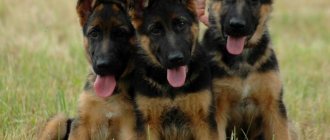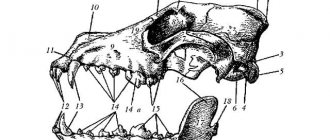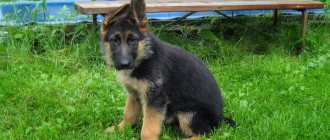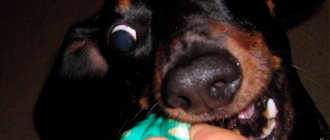Types of “Germans” by color
According to the standard, there are four main options:
- black;
- black and tan;
- zonal;
- black colored dogs.
German Shepherds are great dogs
The former are considered a kind of elite of the world of shepherd dogs; they are very rare (only 5% of the representatives of the breed). A small amount of brown hair is allowed between the toes and on the hocks. The standard also allows a gray undercoat on the pet’s neck and shoulders.
For your information! An interesting trend was noted by M. Ray, an American breeder specializing in precisely these types of breeds. If you purposefully study this color, then in each subsequent generation the proportion of brown-gray inclusions decreases, and the puppies of the fourth generation are already charcoal.
Black and tan dogs are beautiful, the tonality of their coat is predominantly black, which is why they can appear charcoal, a copy of the previously described variety.
The Zonar is the oldest variant of the German Shepherd, called the Agouti. Each hair is colored in several shades: white at the base of the hair, then yellow-brown along the main length, and black at the tip. This coloring helped wild dogs to camouflage themselves in nature while tracking down prey. The dominant gene contributes to this coloration.
Black and red is a black and red color variant that is considered the most popular. It is these animals that become prize-winners at monobreed exhibitions.
German Shepherds are amazingly beautiful
Standard colors
Three genes are responsible for the color of a German Shepherd: a (black), aw (zoned) and at (black and tan). It was these three genes that determined the shade of the coat. Non-standard colors are the result of mutation.
German Shepherd weight by month: table
Representatives of the breed come in both short and long hair. During puppyhood, it is impossible to determine the length of the coat; it becomes obvious only with age.
Note! The undercoat, regardless of the main tone, is always gray. White does not meet the standard.
Cheprachny
Considered the most popular, this is what the classic shepherd looks like - red with a black muzzle.
Peculiarities:
- the hair has a dark brown base;
- there is a black saddle cloth, similar in shape to a horse blanket. Consists of guard hairs;
- the top of the neck is decorated with a coal mantle. It covers the back, shoulders of the animal, goes to the stomach and tail;
- There are tan marks on the stomach, neck, and paws. Tones - chocolate, fawn, gray;
- the mask on the face is gray or dark.
For your information! The sable color of the dog comes in three varieties: rich, darkened and weakened. In this case, dark bitches on the back may have a “salt and pepper” coloring. For males, this option is permissible only with a weakened variety of tone.
Black-backed German Shepherd - a classic of the genre
Black and Tan
Distinctive features of animals of this color:
- dominance of dark shade;
- pronounced black mask;
- thick undercoat;
- there are brown spots on the limbs;
- obligatory tan near the anus;
- Lightened eyebrows, cheekbones and chest are acceptable.
In cynology, there are three subtypes of this color - saturated, weakened and darkened. There is a predisposition to fading: puppies have a less saturated tone than their parents.
Black and Tan "Germans"
Black
A very rare color, there are practically no animals left with the ideal breed exterior of charcoal coloring. Such dogs are used in mating with those with lighter coats in order to improve pigmentation in the offspring. This result can be achieved if dark ancestors predominated in the pet’s pedigree.
The reason for the rarity of the shade is that the gene responsible for it is recessive. Often in a litter of black and pale black dogs, the babies are pale black. White spots are considered a defect.
For the first time such animals attracted attention at an exhibition in 1906, when Roland von Stankerburg, a German shepherd, was named the absolute champion. She was mistakenly mistaken for a new breed, but when the truth became clear, interest in the color continued.
Note! Initially, such dogs were considered defective and were not used for breeding.
Black “Germans” are larger than other representatives of the breed, they have a straight back (other shepherd dogs have a convex one), long, silky hair, the back of the head and chest are decorated with a luxurious collar.
Black "German" - elite of the breed
German Shepherd of zonal color
This color option makes the shepherd look like a wolf. Distinctive features:
- guard hair has a dark tip;
- at the base of the hair is white, along the length - light brown;
- the undercoat is gray, although visually it appears black, especially from a distance;
- The tail, muzzle and back have a rich tone. The sides are lighter.
Three zoning options are allowed: weakened, black sable (it will be discussed separately) and rich.
The color saturation of the animal changes depending on age. Puppies are born dark, almost charcoal. Then, after molting and getting rid of fluff, the owners unexpectedly lighten up. When their skin becomes overgrown with “adult” hair, the pet becomes dark again. The older the animal, the more saturated the color of its coat.
German Shepherd of zonal color
Dark sable or black-zoned
The color is also called wild or wolf. Outwardly, the animal appears brown-black, but it is not so. Peculiarities:
- the underbelly, tail, limbs, ears and neck look light (gray or red);
- the shade can be weakened, saturated or darkened.
These are the standard colors of representatives of the breed. If the animal is free of defects, it can be accepted in international exhibitions.
Sheepdog color dark sable
Zone gray
The zone-gray color is considered the most unusual type, which is inherent in the “German” breed. The zonal color is also called “wolf”, and if you look at the photographs, it will immediately become clear why. A distinctive feature of the zonal color is the areas where you can observe alternating coats of yellow and black colors.
Related article: Symptoms and treatment of German Shepherd diseases
A zoned German Shepherd can be born if at least one of its parents is gray in color. It so happens that this type has the highest working capacity, which is why the gray shepherd is used for various jobs.
Non-standard suits of the “Germans”
Unusual animal colors are the result of mutation. Such dogs are not allowed to breed, although they often look very impressive and are the decoration of nurseries.
Black and white shepherd
Training a German Shepherd at home
Color variation is not recognized as a standard, despite the fact that pets with white spots on their chests look very pretty. The working qualities of such animals are no different from the breed varieties. Eye color is always dark, brown or chocolate. The main shade is black, snow-white is represented by only a few spots.
Note! White spots are a defect even in those dogs that have a classic standard color.
Gray (blue)
If the black shade of the coat is lightened, a blue or gray shepherd appears. Such pets are discarded because their dark color has reduced pigmentation. However, in the United States, such pets are in fashion, so 4 shades have been developed, including those with silver splashes. The eyes of these dogs are light yellow.
Blue puppies appear very rarely in a litter; the non-standard color is associated with an additional gene. The presence of red tan marks is allowed. The performance characteristics of the gray animal are indistinguishable from those of its standard relatives.
This pet will never be able to take part in exhibitions
White German Shepherd
A snow-white puppy can appear in the litter of ordinary parents, but only if both have a recessive gene responsible for color. Breeders and fanciers liked the unusual dogs so much that in 2003 they were recognized as a separate breed in the USA and Canada.
Note! They cannot be called albinos, since their nose and claws are black, and the irises of their eyes are dark.
The edging of the mouth and eyelids is dark, and there is black skin next to the nose. Unlike snow-white cats, dogs do not suffer from deafness. Light spots can occur in animals of other colors, but this is grounds for culling.
These animals are distinguished by their good-natured character and good performance characteristics. However, they lose to other shepherd dogs in guard duty. Such dogs are sociable and sincerely become attached to the owner. They rarely show aggression, but are ready to bravely defend the owner and members of his family.
White “Germans” are not albinos
Golden
This is a variety of red color, a lightened version. Animals do not have the right to engage in exhibition activities and are not allowed to breed offspring. The wool is light, beautiful golden tone. There may be light or even white spots on the chest.
Note! There is a black edging around the eyes, the muzzle is decorated with a dark mask.
The Golden German Shepherd is not recognized by the breed standard.
Brindle color
It is considered extinct, although previously it was the tiger coat of shepherd dogs that was considered the most popular. The gene for this color is expressed in tan: with saddle and black and tan base colors, black areas of the hair are observed, which is why the coat resembles a brindle. The option is interesting, shepherd dogs look very attractive, but at the moment breeders are not trying to revive the color.
Red-haired "Germans"
The red shepherd has a recognizable, interesting appearance, but the color variant is not recognized as a standard. The pet will become a loyal friend and family member, but will not be able to take part in exhibition activities. Such dogs are not allowed to breed. They can be either long-haired or short-haired. The color of the coat can be reddish-brick. Such shepherd dogs are born extremely rarely. The fur coat will be decorated with white spots of various shapes and sizes.
Note! A bright red tone is allowed as an additional color for black and tan coloring, as well as on the markings for black and tan varieties.
There are also spotted “Germans”; their fur is decorated with pigment spots of various shapes and sizes. Most often, these are not purebred dogs, but the result of a mating of a purebred shepherd dog with a yard dog.
Red color allows for tan marks
Other colors
In addition to the described coat colors of these guard dogs, there are several more varieties that are unanimously recognized as mutations in the “Germans”.
Related article: Genetics and groups of the long-haired German Shepherd
Blue. There are “Germans” who have a similar coat color. Essentially it is a gray German Shepherd of a certain shade. In fact, blue wool is formed by the bleaching of black. Dogs with similar colors are clearly recognized by specialists as defective. And although they look quite cute, your pet will not be able to participate in exhibitions. That, however, will not prevent him from being your faithful friend and assistant.
Yellow. If a certain pigment ("E") is present, some Germans may have a coat that is close to yellow in color. Although this type of mutation is extremely rare, sometimes we can see representatives of this breed with unusually light, almost golden hair.
Spotted. Teak spotting may appear some time after birth and appears as multiple pigmented spots scattered throughout the German's coat.
Roan. Another deviation from the norm. Dogs that have the “G” gene are faced with the fact that over time they have more and more “gray” areas. Sometimes there are more such gray hairs than dark ones, and then this color is called roan.
Eye and skin color
How to tell a German Shepherd puppy from a mongrel
In accordance with the breed standard, the eyes of representatives of the breed should be dark, but not black. The shade of the iris has nothing to do with the shade of the animal's fur. It happens that a dog with a dark coat color has lighter eyes and vice versa.
For your information! There is a position among dog handlers that the shade of the iris should match the tone of the fur coat, then the pet will look more attractive.
Animals with a light, blurry color are characterized by the following features:
- dark rim around the eyes.
- tongue with small black spots.
Note! The skin of representatives of the breed is gray-blue, pink in the tan areas. The nose is always dark and deep in tone.
The eye color of the “Germans” is dark brown
Black
“Germans” in black are extremely rare, which is why the price for them is usually much higher. According to statistics, only 3–5% of dogs of this breed have this coloring. They may have brown hairs around the toes, but the overall body should be completely black, with no areas of a different color.
Similar article: What is the difference between a German Shepherd and an Eastern European one and which is better?
A defect for this type of coloring is the presence of spots of a different color.
Despite the fact that the percentage of representatives of this breed with a similar coat color is catastrophically small, there are many other varieties of the breed that are often born completely black: Australian, Scottish, Belgian, Greek.
Skin pigmentation
Particularly expressive to the representatives of the breed is the mask - the part of the muzzle around the eyes, which is most often completely black. The dominant gene is responsible for it. If the animal's fur is dark in color, the mask is often weakly expressed. A pet with a light coat has a more saturated color of the mask. Its absence is considered a breed defect.
The black and tan animal does not have a mask, its muzzle is black. The throat area is colored brown, the edging of the lips is liver-colored.
The color of the eyebrows and forehead of saddle-backed shepherd dogs directly depends on the tone of the saddle coat. If its color is deep dark, then the animal’s forehead is also charcoal. An expressionless lightened mantle is in harmony with light eyebrows.
Note! The zone-colored German Shepherd has sable eyebrows.
These are the main color options for shepherd dogs. Those who want to engage in breeding or take part in exhibitions with their pet should choose a dog with a recognized standard color. If these points are unimportant, then the choice is richer: you can buy a golden or red puppy. A dog's intelligence and working qualities are in no way related to the color of its coat.
A little about genetics
If the puppy has good pigment, most likely, half of its body will be black, and the tan will be uniform (shades will vary from yellow to bright red). There are four main colors: black, saddleback, black and tan and zoned gray. In addition, there are red and white German Shepherds.
Initially, the color of the German Shepherd was influenced by three main genes: a (responsible for the completely black coat color), aw (zonal gray or simply zone color), at (gene responsible for the black and tan color of the dog). It is these genes that create the colors that are most common in puppies and adult dogs. The colors that appeared in the German Shepherd later are mutations that appear only in the form of light spots or an insignificant change in pigment. There are no dogs of this breed with a color that is radically different from the standard.
It is also worth noting that no matter what the color of the coat, the dog’s nose should always be black. Any other color (brown, chocolate) is considered a defect.











